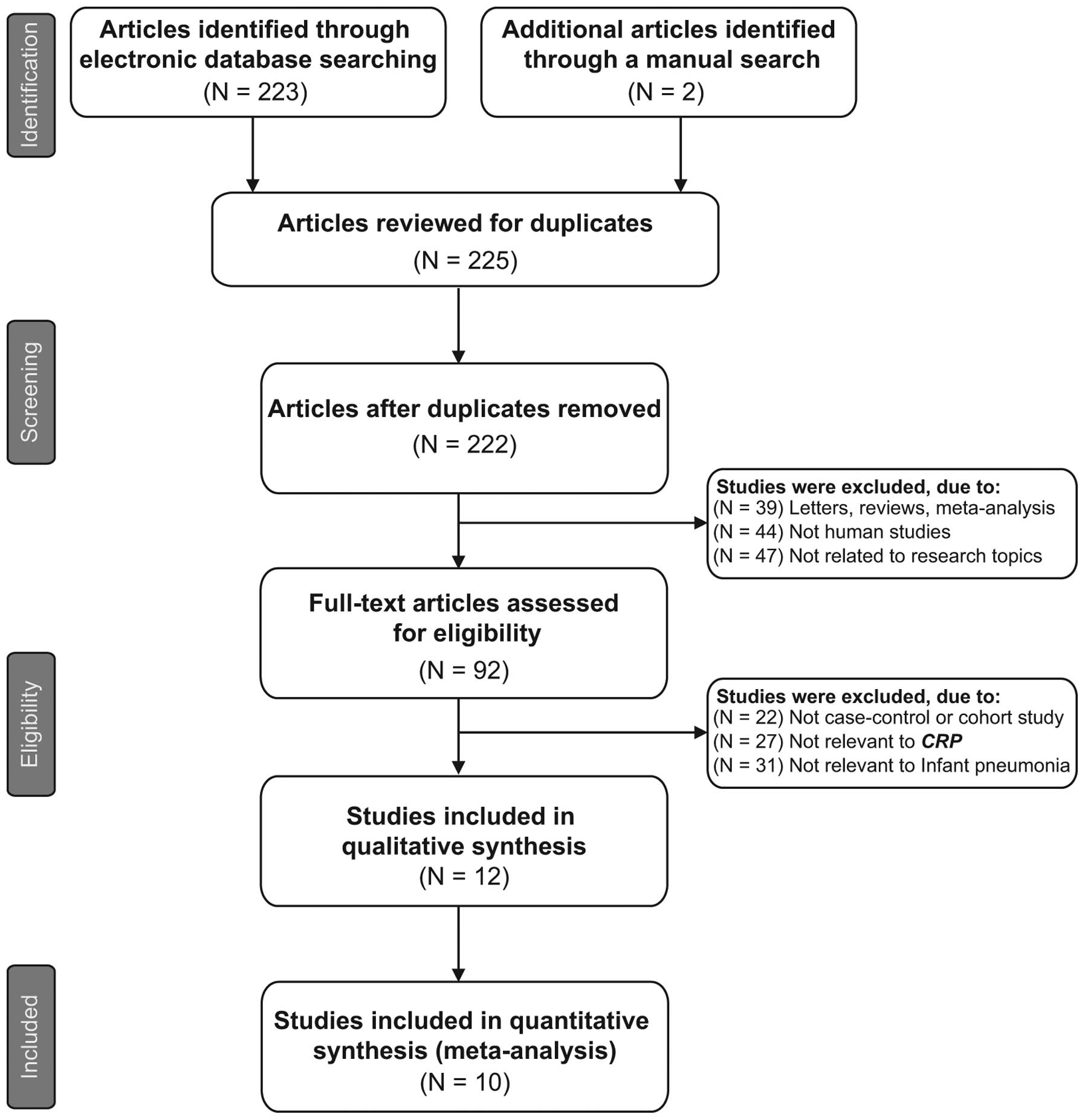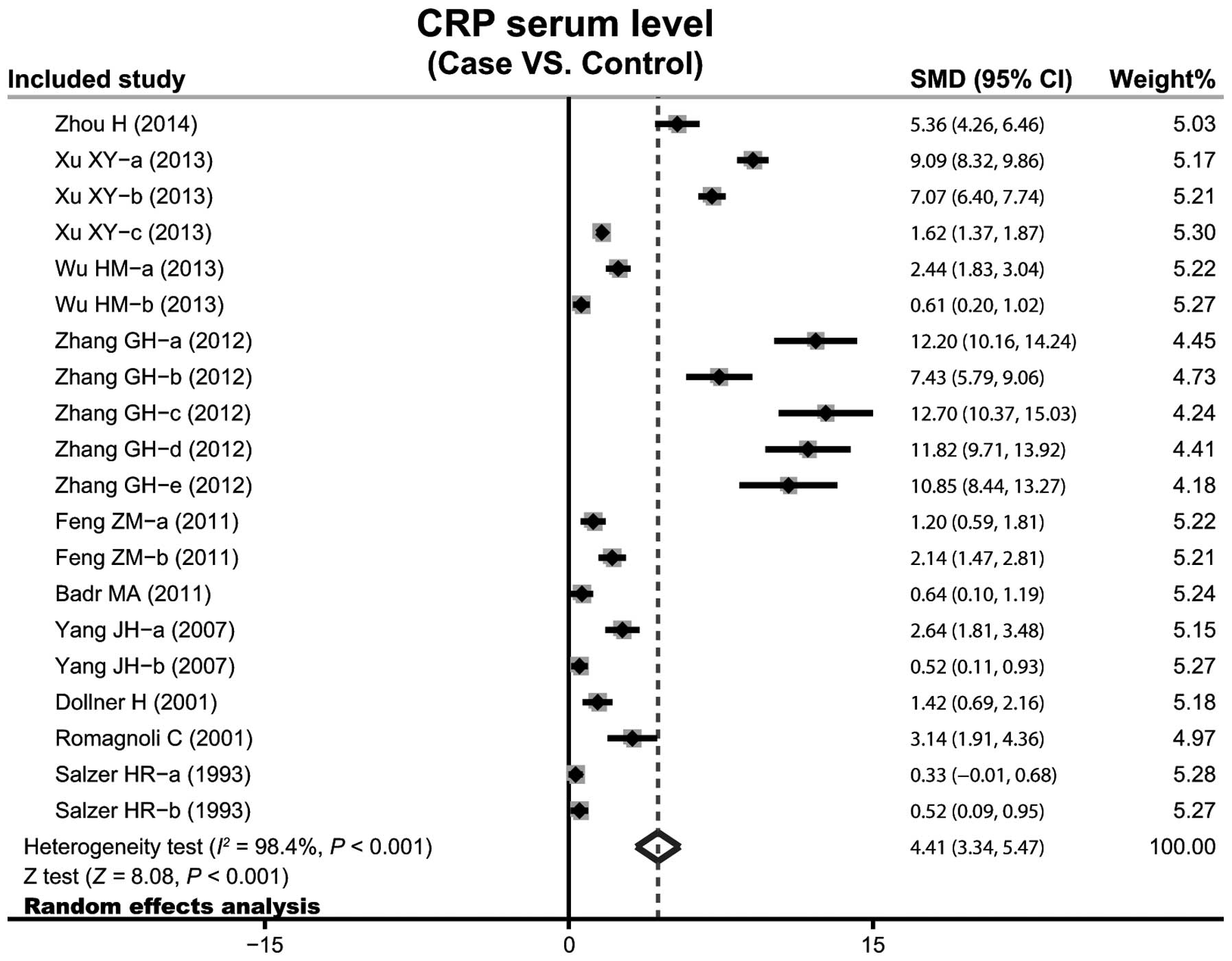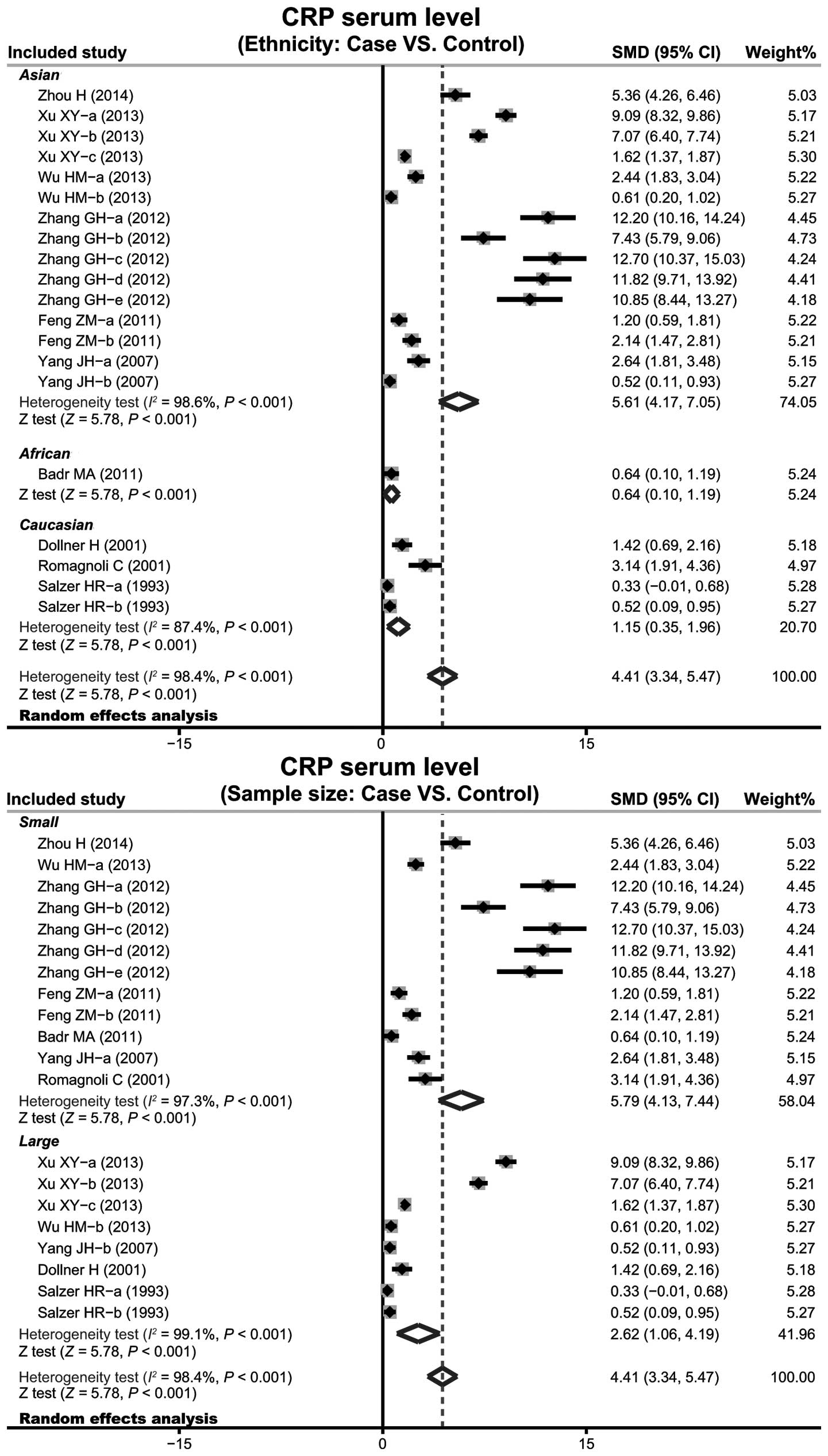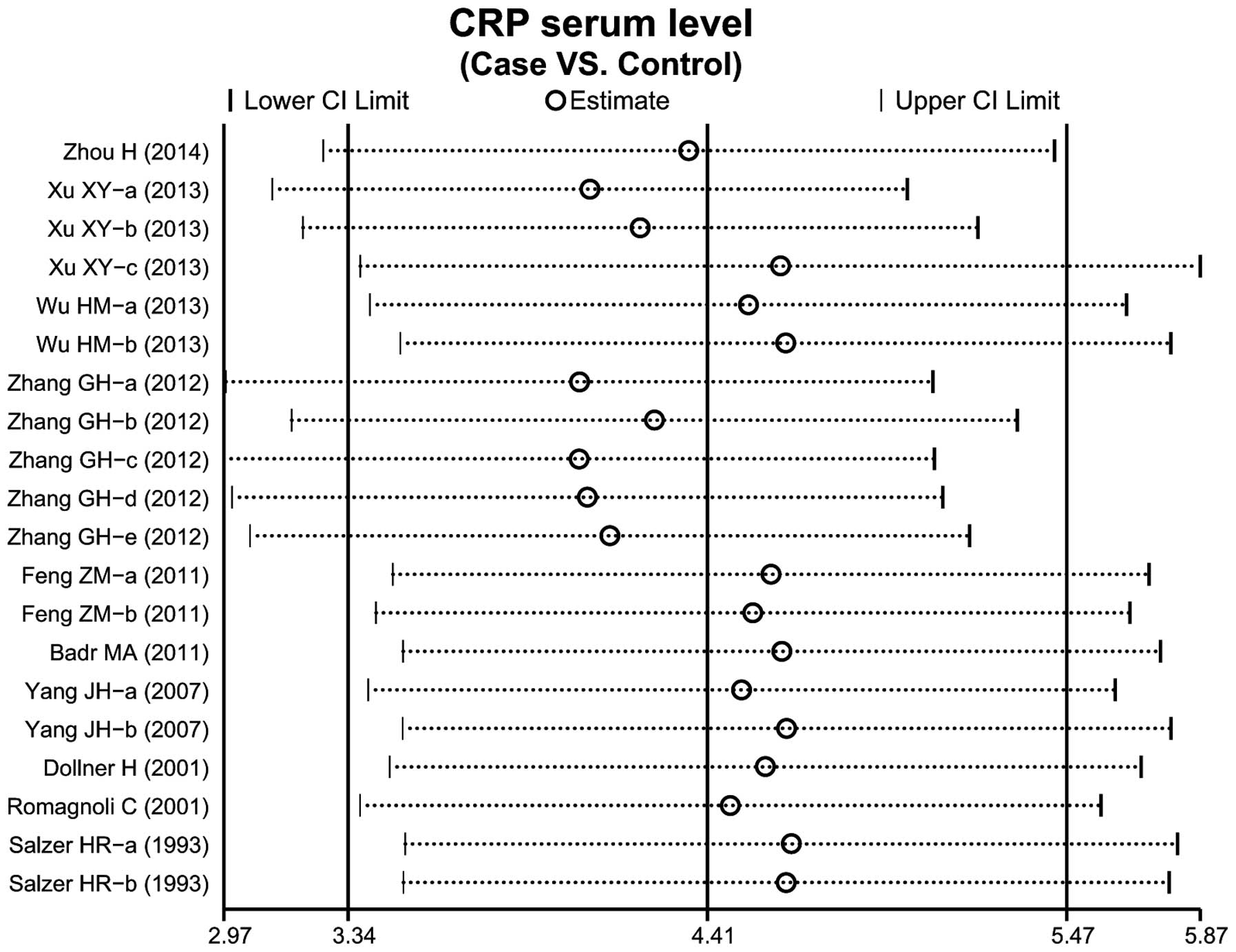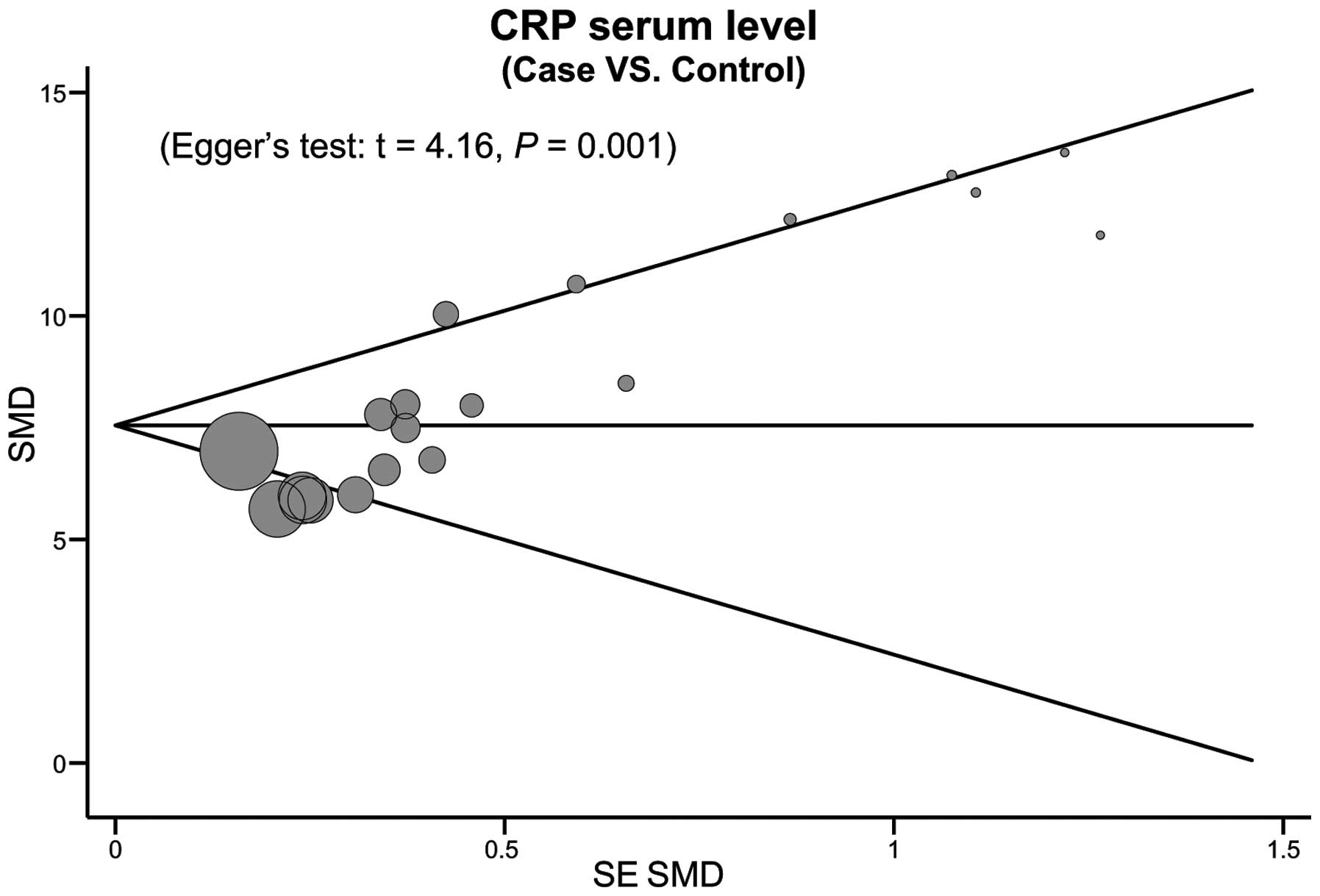Correlation between serum levels of C-reactive protein and infant pneumonia: A meta-analysis
- Authors:
- Published online on: April 8, 2015 https://doi.org/10.3892/etm.2015.2417
- Pages: 2331-2338
Abstract
Introduction
Infant pneumonia, which is caused by infection with viruses or bacteria, has aroused public concern due to the substantial mortality and incidence in children worldwide (1,2). There are ~750,000 neonatal mortalities associated with pneumonia each year, which constitute >10% of child mortalities worldwide (3). The majority of these mortalities occur in low income areas; in proportion of cases occurring in developing countries is ~96%, and >90% of the estimated 1.6 million annual pneumonia mortalities in children <5 years of age (1,4,5). Mortality rates are >70% in south Asia and sub-Saharan Africa, where the incidence of pneumonia is estimated to be 0.36 (interquartile range, 0.32–0.40) episodes per child-year (2). Worldwide, the neonatal period is the most significant for pneumonia; at least one-third of the annual 10.8 million mortalities in children occur in the first month of life (6). Moreover, infant pneumonia may be early or late onset, where early-onset neonatal pneumonia is generally considered to be a clinical manifestation in the first week of life, while the latter occurs in the following 3 weeks (7). Clinically, infant pneumonia is considered as a multifactorial disease affected by quality of life, poor immunization, air pollution, nutritional status, and other factors (2). Large quantities of bacteria and viruses may to be associated with infant pneumonia, with viral neonatal pneumonias including intrauterine, early-onset or late-onset pneumonias (6). It has been suggested that C-reactive protein (CRP) may be one of the best single tests for the early detection of pneumonia in children, and could be widely used as marker of infection (8).
C-reactive protein (CRP), an acute phase plasma protein of the pentraxin family, is produced and released by hepatocytes and adipocytes, playing distinct roles in innate and adaptive immunity with inflammatory effects (9,10). Moreover, it has been identified to be a sensitive and reliable factor of acute inflammation in infectious as well as in non-infectious inflammatory disorders (11). In previous studies, CRP has been reported to function by binding to the phosphocholine moieties that are located on some damaged cells and certain bacteria, and to have a crucial part in complement activation through strengthening phagocytosis, which may clear dead cells and bacteria (12,13). In the acute phase, an extensive inflammatory environment, such as bacterial, viral and fungal infection, rheumatic conditions, malignancy and tissue damage, may induce the expression of interleukin (IL)-6 as well as other factors, such as IL-1β and tumor necrosis factor (TNF)-α, which may be associated with an enhancement of CRP expression (14–16). In clinical practice, systemic inflammation may cause a significant increase in the serum CRP level that is considered to be a main risk factor for inflammatory disease, myocardial infarction, peripheral vascular disease and ischemic stroke (17,18). It has been demonstrated that CRP may take part in the pathogenesis of atherosclerosis through the promotion of endothelial cell activation and foam cell generation within the arterial wall (19,20). Previous studies have identified the significant role of the serum CRP level in the development and prognosis of pneumonia, and have reported that an increased serum level of CRP may be present in patients with pneumonia (21,22). In particular, it has been found that the serum CRP level may be useful for distinguishing bacterial pneumonia from nonbacterial pneumonia in children, as higher serum CRP concentrations were observed in cases with a bacterial etiology (23,24). On the basis of this evidence, it may be hypothesized that the serum CRP level is closely correlated with the progress and severity of infant pneumonia (25,26). By contrast, a small number of studies have found that an elevated serum level of CRP is relatively non-specific and cannot predict the prognosis of infant pneumonia (27,28). Accordingly, the purpose of the present meta-analysis was to provide clarify whether an increased serum level of CRP accelerates the development of infant pneumonia and may be regarded as a poor prognostic marker.
Materials and methods
Search strategy
Related articles were identified by searching PubMed, Embase, Cochrane Library, CINAHL, CBM and CNKI databases comprehensively for all pertinent papers, which assessed the correlations between CRP serum levels and infant pneumonia and were published up to May 31, 2014. The search terms used were (‘C-reactive protein’), (‘infant, newborn’ or ‘newborn infants’ or ‘newborns’ or ‘neonates’), and (‘pneumonia’ or ‘pneumonia, mycoplasma’ or ‘primary atypical pneumonia’ or ‘mycoplasma pneumonia’ or ‘Mycoplasma pneumoniae pneumonia’) for the initial search. No limitation was set on the language of the article. Additional potentially relevant papers were further retrieved by a manual search of references from the original articles.
Selection criteria
Any randomized human-associated intervention case-control studies that involved the association of CRP serum levels with infant pneumonia as a primary outcome were initially taken into consideration. With the exception of healthy participants, studies concerning patients whose ages ranged from 7 days to 36 months and who were diagnosed with infant pneumonia confirmed by histopathologic examinations according to the World Health Organization (WHO) guidelines for the interpretation of chest radiographs, were also included for the initial review of articles (29). Studies that did not provide the number of infant pneumonia cases, or sufficient information about serum CRP expression levels, were not included in the meta-analysis. Extracted studies in which the minimum number of cases was not >20 were not excluded. However, extracted studies that had a considerable overlap (>50%) of study subjects or lack of complete data or unavailable data were excluded. If the same population was investigated in more than one study, only the most recent or complete study was included following careful reexamination.
Data extraction
In order to reduce bias and enhance credibility, two investigators extracted information according to the selection criteria separately, and arrived at a consensus on all the items through discussion and reexamination. The following relevant data were extracted from eligible studies prospectively: Surname of first author, year of publication, source of publication, study type, study design, sample size, age, gender, ethnicity and country of origin, detection method of CRP serum levels, and CRP expression levels. As there were subjects of different ethnicities, information was extracted separately into classes for Asian, African and Caucasian populations. All authors approved the final decision concerning the studies to be included.
Quality assessment
To decide whether a study was of high quality, the two authors used a set of predefined criteria based on the Newcastle-Ottawa Scale (NOS) criteria to assess the studies independently (30). The NOS criteria were scored based on three aspects: i) subject selection, 0–4; ii) comparability of subject, 0–2; and iii) clinical outcome, 0–3. Total NOS scores range from 0 (lowest) to 9 (highest). According to the NOS scores, the included studies were classified into two levels: low quality (0–6), and high quality (7–9). Discrepancies in the NOS scores of the included articles were resolved by an additional reviewer through discussion and consultation.
Statistical analysis
In order to supply quantitative evidence from all selected studies and minimize the variance of the summary, the current statistical meta-analyses was conducted utilizing a random-effects model (DerSimonian and Laird method) or a fixed-effects model (Mantel-Haenszel method) of individual study results under the situation where data from independent studies could be combined. A random-effect model was applied when heterogeneity existed among studies, while a fixed-effect model was applied when there was no statistical heterogeneity. The summary standardized mean difference (SMD) with 95% confidence intervals (CIs) was calculated for case versus control categories of serum CRP levels, with utilization of the Z-test. Subgroup meta-analyses were also conducted by ethnicity and sample size to explore potential modification effects, and heterogeneity across the enrolled studies was evaluated by the Cochran's Q-statistic; P<0.05 was regarded as statistically significant (31). As a result of the low statistical power of the Cochran's Q-statistic, an I2 test was also used to reflect the possibility of heterogeneity between studies (32). Sensitivity analysis was performed to reflect the effect of an individual data set on the pooled SMDs. A funnel plot was constructed to assess publication bias which might affect the validity of the estimates. The symmetry of the funnel plot was further evaluated by Egger's linear regression test (33). All tests were two-sided and a P-value of <0.05 was regarded as statistically significant. To ensure that the results were credible and accurate, Stata software, version 12.0 (Stata Corp, College Station, TX, USA) was used for statistical analysis.
Results
Baseline characteristics of the included studies
The original search yielded a total of 225 papers associated with the searched keywords and a flow chart of the study selection process is presented in Fig. 1. Through the step of screening the title and key words, 133 of these articles were excluded (3 were duplicates, 39 were letters, reviews or meta-analyses, 44 were not human studies, and 47 were not related to the research topics). The full-texts from 92 articles were reviewed and an additional 80 trials were excluded (22 were not case-control or cohort studies, 27 were not relevant to CRP and 31 were not relevant to infant pneumonia), leaving 12 studies for further review. Of these, 2 were abandoned as they did not supply enough information; therefore, 10 papers (25–28,34–39), which included 652 patients with infant pneumonia and 845 healthy controls, were finally found to conform to the inclusion criteria. Publication years ranged from 1993 to 2014. The articles were case-control studies that evaluated the correlation between CRP serum levels and infant pneumonia in Asian populations (6 studies), African populations (1 study) and Caucasian populations (3 studies). The detection methods applied were enzyme-linked immunosorbent assay (ELISA) and immunonephelometry. Immunonephelometry is the most commonly method utilized in the studies included in the present meta-analysis. All quality scores of the enrolled papers were >7 (high quality). Table I summarizes the characteristics and methodological quality of the extracted studies. The number of articles selected from the electronic databases over the years 2001 to 2014 are shown in Fig. 2.
CRP serum levels in infant pneumonia
A total of 10 case-control studies considered the CRP serum levels in infant pneumonia. The results concerning the correlation between the levels of CRP and infant pneumonia are presented in Fig. 3. The random-effects model was used as heterogeneity existed (P<0.001). The meta-analysis results identified a positive association between CRP serum levels and infant pneumonia (SMD=4.41, 95% CI: 3.34–5.47, P<0.001). Subgroup analysis based on ethnicity implied that high levels of serum CRP may be the main risk factor of infant pneumonia in Asian (SMD=5.61, 95% CI: 4.17–7.05, P<0.001), African (SMD=0.64, 95% CI: 0.10–1.19, P<0.001) and Caucasian (SMD=1.15, 95% CI: 0.35–1.96, P<0.001) populations (Fig. 4). Further subgroup analyses by sample size showed an clear association between the levels of CRP and infant pneumonia in large sample and small sample subgroups (small sample size: SMD=5.79, 95% CI: 4.13–7.44, P<0.001; large sample size: SMD=2.62, 95% CI: 1.06–4.19, P<0.001).
Sensitivity analysis and publication bias
Each study enrolled in the meta-analysis was evaluated one by one to reflect the effect on the significance of the pooled SMDs. The results of the sensitivity analysis indicated that the overall statistical level of significance did not change when any single study was omitted, showing that the current meta-analysis data is relatively stable and credible (Fig. 5). The funnel plots of the 10 included studies exhibit a slight asymmetry, and Egger's test showed a publication bias in this meta-analysis (t=4.16, P=0.001; Fig. 6).
Discussion
The current meta-analysis considered previous findings from relevant studies in an attempt to determine the correlation between serum levels of CRP and the pathogenesis of infant pneumonia. The principal results of this meta-analysis indicate that the serum CRP levels of newborn infants with pneumonia were higher than those of healthy subjects, indicating that increased serum levels of CRP might be an important risk factor for the occurrence of pneumonia in newborn infants. CRP, a major acute phase protein, is a member of the pentraxin family and plays a central role in innate and adaptive immunity (40). The production of CRP is stimulated to a large extent by TNF-α, IL-6 and IL-1β in response to infection or inflammatory conditions (41). To be specific, a reduction in serum CRP levels may present a relief or alleviation of the inflammatory process, whereas persistently upregulated levels of CRP or an initial reduction followed by a further elevation might indicate persistent inflammation and poor prognosis (42). Serum levels of CRP are usually very low and difficult to detect in normal blood, but may increase rapidly to significantly high levels at a very early stage of the infection process (43). More importantly, CRP has been indicated to be capable of protecting against bacterial infection by binding to the pneumococcal C-polysaccharide and opsonization of the bacteria for phagocytosis and killing (41,43). Bacterial infection is a crucial risk factor leading to the development of neonatal pneumonia (44). In this regard, it is reasonable to conclude that serum CRP levels may be implicated in the etiology of pneumonia in newborn infants. In accordance with the results of the present meta-analysis, Koster et al measured the serum levels of CRP in children and found that serum CRP levels were independently correlated with pneumonia, indicating that the detection of serum CRP levels may have independent value in the diagnosis of pneumonia in children in an emergency department with potential pneumonia (24). Furthermore, Mintegi et al conducted a prospective multicenter study based on 188 children younger than 36 months cared for in pediatric emergency departments, and suggested that serum levels of CRP might be helpful in predicting the risk of occult pneumonia in infants with high fever without source (45).
Stratified analysis on the basis of ethnicity and sample size was rigorously implemented for the purpose of acquiring a more accurate and profound understanding of serum CRP levels in the etiology of pneumonia in newborn infants. The findings of the ethnicity-stratified analysis revealed that newborn infants with pneumonia had higher serum levels of CRP compared with healthy controls among Asian, African and Caucasian populations, implying that ethnicity is not a dominant factor impacting on the overall results of this meta-analysis. The major discovery of the present meta-analysis, which is partially in conformity with previous studies, is that serum CRP levels may participate in the development and progression of pneumonia in newborn infants, implying that serum levels of CRP may be utilized as a valuable biomarker in the early prediction of the occurrence and progression of pneumonia in newborn infants.
However, the current meta-analysis has certain limitations. Firstly, retrospective studies have innate limitations by nature. This study was conducted with retrospective data collection, where tests were prone to rely on previous information, and baseline characteristics in the cases and controls varied considerably, all of which may contribute to a possible selection bias. Secondly, although a methodological assessment of the studies was performed to avoid selection bias, there was a highly significant heterogeneity among the 10 evaluable articles, which may be attributed to the fact that the technique used to detect CRP and the different backgrounds of the patients may be not comparable among studies. Thirdly, the potential publication bias in this study; Egger's test showed a publication bias in the current meta-analysis. In addition, language may also introduce bias, particularly since only eligible English or Chinese studies were selected while certain potentially qualified studies were excluded based on language criteria. A fourth potential limitation is the relatively small sample size; the results of this study require confirmation in prospective randomized controlled trials with larger study populations. The above limitations may make the data unsuitable for analysis by multiple logistic regression and calculation of SMDs to some extent. Regardless of the limitations, to the best of our knowledge, this is the first example of a meta-analysis concerning the association of serum CRP levels with the development of infant pneumonia. With the application of a statistical approach to combine the results from multiple studies in this meta-analysis and to achieve strong objectivity, all research methods were carried out with strict inclusion and exclusion criteria, suggesting that obtained information may approximate the actual situation.
In conclusion, the results of this meta-analysis showed that a higher serum CRP level is closely correlated with the progression of infant pneumonia. CRP as a general systemic inflammation biomarker may help clinicians to make difficult therapeutic decisions for infant patients with pneumonia, according to the present data. If the current results are confirmed by further studies with larger sample sizes, the use of CRP may improve the present diagnostic strategies for pneumonia in children in pediatric clinical practice.
Acknowledgements
The authors would like to acknowledge the reviewers for their helpful comments on this paper.
References
|
Diez-Padrisa N, Bassat Q, Machevo S, et al: Procalcitonin and C-reactive protein for invasive bacterial pneumonia diagnosis among children in Mozambique, a malaria-endemic area. PLoS One. 5:e132262010. View Article : Google Scholar : PubMed/NCBI | |
|
Banstola A and Banstola A: The epidemiology of hospitalization for pneumonia in children under five in the rural western region of Nepal: a descriptive study. PLoS One. 8:e713112013. View Article : Google Scholar : PubMed/NCBI | |
|
Seif El Dien HM and Abd ElLatif DAK: The value of bedside Lung Ultrasonography in diagnosis of neonatal pneumonia. Egypt J Radiol Nucl Med. 44:339–347. 2013. View Article : Google Scholar | |
|
Zaidi AKM, Ganatra HA, Syed S, et al: Effect of case management on neonatal mortality due to sepsis and pneumonia. BMC Public Health. 11 (Suppl 3):132011. View Article : Google Scholar : PubMed/NCBI | |
|
Falade AG and Ayede AI: Epidemiology, aetiology and management of childhood acute community-acquired pneumonia in developing countries - a review. Afr J Med Med Sci. 40:293–308. 2011.PubMed/NCBI | |
|
Nissen MD: Congenital and neonatal pneumonia. Paediatr Respir Rev. 8:195–203. 2007. View Article : Google Scholar : PubMed/NCBI | |
|
Bang AT, Bang RA, Morankar VP, Sontakke PG and Solanki JM: Pneumonia in neonates: can it be managed in the community? Arch Dis Child. 68:550–556. 1993. View Article : Google Scholar : PubMed/NCBI | |
|
Hansen AB, Verder H and Staun-Olsen P: Soluble intercellular adhesion molecule and C-reactive protein as early markers of infection in newborns. J Perinat Med. 28:97–103. 2000. View Article : Google Scholar : PubMed/NCBI | |
|
Swede H, Hajduk AM, Sharma J, et al: Baseline serum C-reactive protein and death from colorectal cancer in the NHANES III cohort. Int J Cancer. 134:1862–1870. 2014. View Article : Google Scholar : PubMed/NCBI | |
|
McDade TW, Rutherford J, Adair L and Kuzawa CW: Early origins of inflammation: microbial exposures in infancy predict lower levels of C-reactive protein in adulthood. Proc Biol Sci. 277:1129–1137. 2010. View Article : Google Scholar : PubMed/NCBI | |
|
Jordan KK, Christensen IJ, Heilmann C, Sengelov H and Muller KG: Pretransplant C-reactive protein as a prognostic marker in allogeneic stem cell transplantation. Scand J Immunol. 79:206–213. 2014. View Article : Google Scholar : PubMed/NCBI | |
|
Mukerji R, Mirza S, Roche AM, et al: Pneumococcal surface protein A inhibits complement deposition on the pneumococcal surface by competing with the binding of C-reactive protein to cell-surface phosphocholine. J Immunol. 189:5327–5335. 2012. View Article : Google Scholar : PubMed/NCBI | |
|
Lu J, Marjon KD, Marnell LL, et al: Recognition and functional activation of the human IgA receptor (FcalphaRI) by C-reactive protein. Proc Natl Acad Sci USA. 108:4974–4979. 2011. View Article : Google Scholar : PubMed/NCBI | |
|
Martins OM, Fonseca VF, Borges I, Martins V, Portal VL and Pellanda LC: C-Reactive protein predicts acute myocardial infarction during high-risk noncardiac and vascular surgery. Clinics (Sao Paulo). 66:773–776. 2011.PubMed/NCBI | |
|
Jones G, Sebba A, Gu J, et al: Comparison of tocilizumab monotherapy versus methotrexate monotherapy in patients with moderate to severe rheumatoid arthritis: the AMBITION study. Ann Rheum Dis. 69:88–96. 2010. View Article : Google Scholar : PubMed/NCBI | |
|
Beisswenger PJ, Brown WV, Ceriello A, et al: Meal-induced increases in C-reactive protein, interleukin-6 and tumour necrosis factor α are attenuated by prandial + basal insulin in patients with Type 2 diabetes. Diabet Med. 28:1088–1095. 2011. View Article : Google Scholar : PubMed/NCBI | |
|
van Wijk DF, Boekholdt SM, Wareham NJ, et al: C-reactive protein, fatal and nonfatal coronary artery disease, stroke and peripheral artery disease in the prospective EPIC-Norfolk cohort study. Arterioscler Thromb Vasc Biol. 33:2888–2894. 2013. View Article : Google Scholar : PubMed/NCBI | |
|
Emerging Risk Factors Collaboration, . Kaptoge S, Di Angelantonio E, Lowe G, et al: C-reactive protein concentration and risk of coronary heart disease, stroke and mortality: an individual participant meta-analysis. Lancet. 375:132–140. 2010. View Article : Google Scholar : PubMed/NCBI | |
|
Huang X, Zhang J, Liu J, et al: C-reactive protein promotes adhesion of monocytes to endothelial cells via NADPH oxidase-mediated oxidative stress. J Cell Biochem. 113:857–867. 2012. View Article : Google Scholar : PubMed/NCBI | |
|
Mogelvang R, Pedersen SH, Flyvbjerg A, et al: Comparison of osteoprotegerin to traditional atherosclerotic risk factors and high-sensitivity C-reactive protein for diagnosis of atherosclerosis. Am J Cardiol. 109:515–520. 2012. View Article : Google Scholar : PubMed/NCBI | |
|
van Vugt SF, Broekhuizen BD, Lammens C, et al: Grace consortium: Use of serum C reactive protein and procalcitonin concentrations in addition to symptoms and signs to predict pneumonia in patients presenting to primary care with acute cough: diagnostic study. BMJ. 346:F24502013. View Article : Google Scholar : PubMed/NCBI | |
|
Hillas G, Vassilakopoulos T, Plantza P, et al: C-reactive protein and procalcitonin as predictors of survival and septic shock in ventilator-associated pneumonia. Eur Respir J. 35:805–811. 2010. View Article : Google Scholar : PubMed/NCBI | |
|
Diez-Padrisa N, Bassat Q, Morais L, et al: Procalcitonin and C-reactive protein as predictors of blood culture positivity among hospitalised children with severe pneumonia in Mozambique. Trop Med Int Health. 17:1100–1107. 2012. View Article : Google Scholar : PubMed/NCBI | |
|
Koster MJ, Broekhuizen BD, Minnaard MC, et al: Diagnostic properties of C-reactive protein for detecting pneumonia in children. Respir Med. 107:1087–1093. 2013. View Article : Google Scholar : PubMed/NCBI | |
|
Xu XY and Li ZF: Value of detection of procalcitonin and C-reactive protein in diagnosis of infectious pneumonia in neonates. Zhonghua Yi Yuan Gan Ran Xue Za Zhi. 23:2515–2517. 2013.(In Chinese). | |
|
Zhang GH, Chen CX and He JQ: Study on the correction between the serum SIL-2R, CRP, myocardial enzyme and neonatal pneumonia. Zhongguo Yi Yao Dao Bao. 9:75–76. 2012.(In Chinese). | |
|
Badr MA, Ali YF, Albanna EA, Beshir MR and Amr GE: Ventilator associated pneumonia in critically-ill neonates admitted to neonatal intensive care unit, Zagazig University Hospitals. Iran J Pediatr. 21:418–424. 2011.PubMed/NCBI | |
|
Salzer HR, Pollak A, Herkner K, Weninger M and Schemper W: Value of measurement of neutrophil elastase-alpha 1 proteinase inhibitor levels in the early diagnosis of neonatal infection. Eur J Clin Microbiol Infect Dis. 12:553–556. 1993. View Article : Google Scholar : PubMed/NCBI | |
|
Ben Shimol S, Dagan R, Givon-Lavi N, et al: Evaluation of the World Health Organization criteria for chest radiographs for pneumonia diagnosis in children. Eur J Pediatr. 171:369–374. 2012. View Article : Google Scholar : PubMed/NCBI | |
|
Stang A: Critical evaluation of the Newcastle-Ottawa scale for the assessment of the quality of nonrandomized studies in meta-analyses. Eur J Epidemiol. 25:603–605. 2010. View Article : Google Scholar : PubMed/NCBI | |
|
Jackson D, White IR and Riley RD: Quantifying the impact of between-study heterogeneity in multivariate meta-analyses. Stat Med. 31:3805–3820. 2012. View Article : Google Scholar : PubMed/NCBI | |
|
Peters JL, Sutton AJ, Jones DR, Abrams KR and Rushton L: Comparison of two methods to detect publication bias in meta-analysis. JAMA. 295:676–680. 2006. View Article : Google Scholar : PubMed/NCBI | |
|
Zintzaras E and Ioannidis JP: HEGESMA: genome search meta-analysis and heterogeneity testing. Bioinformatics. 21:3672–3673. 2005. View Article : Google Scholar : PubMed/NCBI | |
|
Feng ZM, Li X and Yang RG: Analysis on detection results of blood lactic acid and C-reactive protein in pneumonic neonates. Zhongguo Yi Yao Dao Bao. 8:85–86. 2011.(In Chinese). | |
|
Wu HM: Value of detection of PCT, hs-CRP and WBC in diagnosis of early neonatal pneumonia. Haixia Yufang Yixue Zazhi. 19:83–84. 2013.(In Chinese). | |
|
Yang JH, Wei XS and Liao B: Significance of the detection of PCT, hs-CRP and IL-6 in diagnosis of neonatal pneumonia. Chongqing Yixue. 36:1194–1195. 2007.(In Chinese). | |
|
Zhou H: Significance of joint detection serum cystatin cand CRP in neonatal pneumonia. Chengde Yixueyuan Xuebao. 31:31–32. 2014.(In Chinese). | |
|
Døllner H, Vatten L and Austgulen R: Early diagnostic markers for neonatal sepsis: comparing C-reactive protein, interleukin-6, soluble tumour necrosis factor receptors and soluble adhesion molecules. J Clin Epidemiol. 54:1251–1257. 2001. View Article : Google Scholar : PubMed/NCBI | |
|
Romagnoli C, Frezza S, Cingolani A, et al: Plasma levels of interleukin-6 and interleukin-10 in preterm neonates evaluated for sepsis. Eur J Pediatr. 160:345–350. 2001. View Article : Google Scholar : PubMed/NCBI | |
|
Volanakis JE: Human C-reactive protein: expression, structure and function. Mol Immunol. 38:189–197. 2001. View Article : Google Scholar : PubMed/NCBI | |
|
Arinzon Z, Peisakh A, Schrire S and Berner Y: C-reactive protein (CRP): an important diagnostic and prognostic tool in nursing-home-associated pneumonia. Arch Gerontol Geriatr. 53:364–369. 2011. View Article : Google Scholar : PubMed/NCBI | |
|
Moreno MS, Nietmann H, Matias CM and Lobo SM: C-reactive protein: a tool in the follow-up of nosocomial pneumonia. J Infect. 61:205–211. 2010. View Article : Google Scholar : PubMed/NCBI | |
|
Marnell L, Mold C and Du Clos TW: C-reactive protein: ligands, receptors and role in inflammation. Clin Immunol. 117:104–111. 2005. View Article : Google Scholar : PubMed/NCBI | |
|
Rudan I, Boschi-Pinto C, Biloglav Z, Mulholland K and Campbell H: Epidemiology and etiology of childhood pneumonia. Bull World Health Organ. 86:408–416. 2008. View Article : Google Scholar : PubMed/NCBI | |
|
Mintegi S, Benito J, Pijoan JI, et al: Occult pneumonia in infants with high fever without source: a prospective multicenter study. Pediatr Emerg Care. 26:470–474. 2010. View Article : Google Scholar : PubMed/NCBI |



